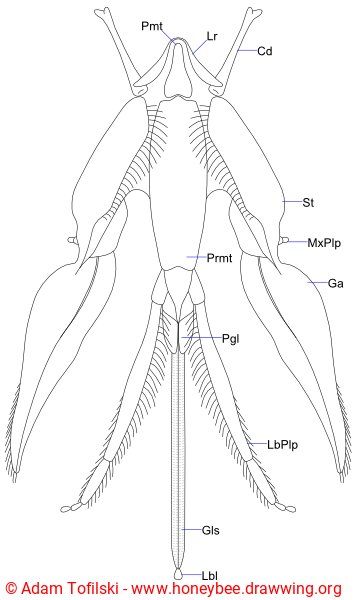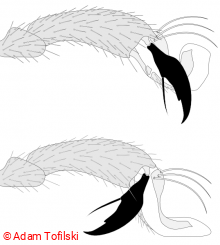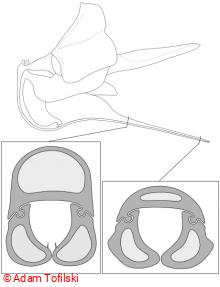
Mouthparts of honey bee worker (posterior view). After Michener (1974, fig. 1.6) The social behavior of the bees: a comparative study,
, Cambridge, Mass., (1974)
[1]. The mouthparts are unfolded and spread apart. Most of the time they are folded behind the head and held together. See also mechanism of folding of the mouthparts.
Cd - cardo (plural cardines)
Ga - galea
Gls - glossa (tongue)
Lbl - labellum
LbPlp - labial palpus
Lr - lorum Anatomy of the honey bee,
, Ithaca, p.334, (1956)
[2], submentum The social behavior of the bees: a comparative study,
, Cambridge, Mass., (1974)
[1]
MxPlp - maxillary palpus
Pgl - paraglossa
Pmt - postmentum Anatomy of the honey bee,
, Ithaca, p.334, (1956)
[2], mentum The social behavior of the bees: a comparative study,
, Cambridge, Mass., (1974)
[1]
Prmt - prementum
St - stipes
The glossa is similar to a long cylinder. The diameter of the glossa is 185.0±1.5 micrometers at the base and 96.6±0.3 micrometers in the middle part. The glossa consists of segments. Length of one segment is about 23 micrometers. On apical part of each of the segments there are 16-20 hairs. The hairs on basal part of the glossa are stiff and short (32 - 63 micrometers long), whereas the hairs on the middle and apical part are longer (171.9±0.3 micrometers long) Effects of erectable glossal hairs on a honeybee's nectar-drinking strategy,
, Volume 104, Number 26, p.263701, (2014)
[3]. At the apex of the glossa there is a spoon-like flabellum. The mouthparts are cleaned with foreleg tarsi Mouthpart grooming behavior in honeybees: kinematics and sectionalized friction between foreleg tarsi and proboscises,
, (2015)
[4].
Ingesting liquid food by bees is based on mechanism of "viscous dipping" Optimal concentrations in nectar feeding,
, Volume 108, p.16618-16621, (2011)
[5]. The tongue is extended and immersed into nectar. At this stage hairs on the glossa erect asynchronously Erection pattern and section-wise wettability of a honeybee's glossal hairs in nectar feeding,
, p.(in press), (2015)
[6]Erection mechanism of glossal hairs during honeybee feeding,
, Volume 386, p.62–68, (2015)
[7] and trap the nectar Discharge and manipulation of labial gland secretion by workers of Apis mellifera (L.)(Hymenoptera: Apidae),
, Volume 39, Number 4-6, p.76–82, (1964)
[8], see also video Optimal concentrations in nectar feeding,
, Volume 108, p.16618-16621, (2011)
[5]. The erectable hairs can increase the ability of a bee to collect nectar Effects of erectable glossal hairs on a honeybee's nectar-drinking strategy,
, Volume 104, Number 26, p.263701, (2014)
[3]. Next, when coated with nectar, the glossa is retracted to a tube formed from galeae and labial palpi. Then the nectar is sucked into pharynx. There are ridges on the inner wall of galeae which can reduce friction during drinking Drag Reduction in the Mouthpart of a Honeybee Facilitated by Galea Ridges for Nectar-Dipping Strategy,
, Volume 12, Number 1, p.70–78, (2015)
[9]Drag reduction effects facilitated by microridges inside the mouthparts of honeybee workers and drones,
, Volume 389, p.1–10, (2016)
[10]. Honey bees are able to imbibe 1.8 microlitres of diluted nectar per second Nectar selection by melipona and Apis mellifera (Hymenoptera: Apidae) and the ecology of nectar intake by bee colonies in a tropical forest,
, Volume 61, p.1-10, (1984)
[11]. This rate is lower in case of higher concentrations of nectar Nectar selection by melipona and Apis mellifera (Hymenoptera: Apidae) and the ecology of nectar intake by bee colonies in a tropical forest,
, Volume 61, p.1-10, (1984)
[11]. It was suggested that the optimal for bees concentration of sugar in nectar, which is a compromise between energy content and intake speed is about 52% Optimal concentrations in nectar feeding,
, Volume 108, p.16618-16621, (2011)
[5] but see Effects of erectable glossal hairs on a honeybee's nectar-drinking strategy,
, Volume 104, Number 26, p.263701, (2014)
[3]. There are sensory organs on the mouthparts which facilitate the food intake Die sinnesorgane an der glossa, dem epipharynx und dem hypopharynx der arbeiterin von Apis mellifica L. (Insecta, Hymenoptera),
, Volume 70, Number 3, p.201–228, (1971)
[12]Electrophysiological responses of galeal contact chemoreceptors of Apis mellifera to selected sugars and electrolytes,
, Volume 22, Number 12, p.1609–1616, (1976)
[13]Motor innervation and proprioceptors of the mouthparts in the worker honey bee, Apis mellifera. I. Mandibular nerve,
, Volume 188, Number 1, p.51–67, (1986)
[14]Motor innervation and proprioceptors of the mouthparts in the worker honey bee Apis mellifera. II. Maxillary and labial nerves,
, Volume 201, Number 1, p.23–37, (1989)
[15].
- Log in to post comments
- Log in to post comments





